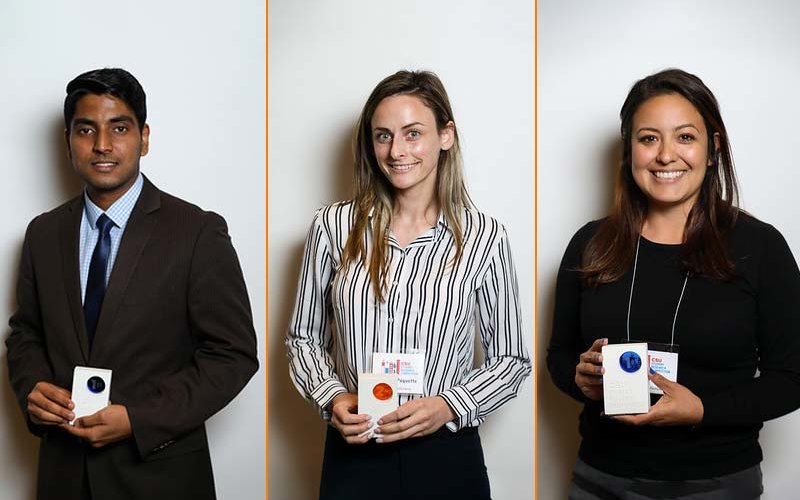
Biology graduate student Evelyn Bond is studying the external reproductive structures of male surfperch to determine the basic reproductive biology of the marine fish.
Mechanical engineering graduate student Thilakraj Shivakumar is researching ways to apply next-generation 3D printing technology that uses less energy consumption to achieve an eco-friendly process.
Undergraduate Kendra Paquette, a psychology major, and Jessica Barragan, who earned a bachelor’s degree in psychology in 2018, delved into research that focuses on eyewitness identifications of disguised suspects since eyewitness misidentifications are the leading cause of wrongful convictions.
For their excellence in innovative research and creative activities, these four Cal State Fullerton researchers received first- and second-place awards at the 33rd annual CSU Student Research Competition. The April 26-27 competition brought together 275 undergraduates and graduate students spanning a range of disciplines from 22 California State University campuses. A total of 10 CSUF students were selected to present their research projects.
Cal State Fullerton hosted this year’s competition, in which students made 10-minute research presentations to judges in 10 categories across 22 sessions. The competition culminated with an awards luncheon, where 44 students were awarded first or second place in their respective categories. Nathalie Carrick, associate professor of child and adolescent studies, and Terri Patchen, professor of elementary and bilingual education, both Student Creative Activities and Research Faculty Fellows, organized the competition, with the help of student assistant and art history major Sydney Adam. Carrick and Patchen also guided students in preparing their oral presentations.
Bond received first place in the Biological and Agricultural Sciences-graduate category for her research titled “The Role of Genital Papillas in the Reproductive Biology of Male Surfperches (Embiotocidae; Teleostei).” Her faculty mentor is Kristy Forsgren, associate professor of biological science.
Shivakumar captured the first-place award in the Engineering and Computer Science-graduate category for his project titled “The Effects of Process Parameters on Mechanical Properties in Liquid Holographic Volumetric Additive Manufacturing Process.” His faculty mentor is Sagil James, assistant professor of mechanical engineering.
Paquette and Barragan, who is entering Claremont Graduate University in the fall to pursue a doctorate in applied psychology, received the second-place award for their research on “When a Perpetrator Wears a Disguise: Which Lineup is Best to Test Eyewitness Memory” in the Behavioral and Social Sciences-undergraduate category. Their faculty mentor is Iris Blandón-Gitlin, professor of psychology.
At the awards ceremony, CSUF President Fram Virjee and Chris Lui, associate vice president for research, welcomed the student researchers to campus. Virjee told the students that immersive research experiences are transformative.
“This research will stay with you for the rest of your life,” Virjee said. “It will be the springboard for your graduate degrees and Ph.D.’s. It will be the foundation for projects that you do in the future and the beginning of ideas that will change the world.”
CSU Chancellor Timothy P. White addressed the students at the awards ceremony via a video message, and Ganesh Raman, CSU assistant vice chancellor for research, gave opening remarks.
White offered his congratulations to the students for being selected to present at the rigorous and respected competition: “You follow in the footsteps of three decades of talented and dedicated student researchers, many of whom are now advancing knowledge in the forefront of their chosen fields.”
Bond, who received a prestigious National Science Foundation Graduate Research Fellowship to support her graduate research and training, relayed that winning the top prize reinvigorates her passion for scientific inquiry on surfperch.
“Winning this award is great validation of what I have achieved, and it is an honor to be recognized among talented graduate students across the entire CSU,” said Bond, who is using various research methods to identify and characterize reproductive tissues to determine the relationship between internal and external reproductive structures. “Personally, I feel very proud to be able to set an example and ensure the presence of Latina women in STEM.”
Thilakraj, who is on track to graduate in August and plans to pursue a doctorate, noted that he is motivated to do research to solve societal problems. “The need for green manufacturing is very important. I’m interested in pursuing the possibilities of simple, creative techniques to address the challenges faced by us in daily life.”
For Paquette and Barragan, their research investigated which lineup was best to test eyewitness memory for a disguised suspect: a standard undisguised lineup or a disguised lineup in which they replicated the disguise on every face in the lineup.
“We hypothesized that the disguised lineup would be best because we encode faces holistically,” said Paquette, who graduates next year and wants to earn a doctorate to continue research in academia.
“If you view an unfamiliar face with glasses, these glasses become a part of the face in your memory. We found that the disguised lineups did improve eyewitness accuracy, but only when the suspect was in the lineup. If we removed the suspect from the lineup, people still chose someone. This suggests that disguised lineups may also increase false identifications.”